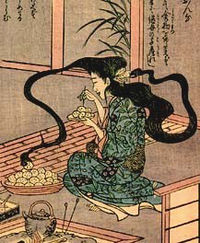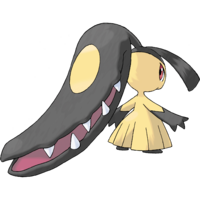On the Origin of Species: Mawile
|
It's disclaimer time: the Pokémon I'm about to discuss happens to be my favorite, so there may be an unusual amount of gushing and squealing about how great it is. I've always loved the third generation designs for their cuteness and quirky ideas, so it should come as no surprise that my favorite Pokémon is cute, quirky and from Generation III.
Ah, Mawile. One of just two pure Steel-types. Its typing and abilities are great. If only its stats weren't so diabolically bad. Still, Mawile has its share of fans, including Junichi Masuda himself (in an interview around the release of Ruby and Sapphire, he singled it out as one of his favorite new Pokémon). Though cursed with sub-par stats, Mawile has been blessed with a cute design... if you can look past the huge set of steel jaws protruding from the back of its head. And therein lies the tale of its origin...
Japanese folklore contains many examples of youkai (妖怪) or monsters. Some are evil, some are not so evil, and most of them are mischievous. Some resemble animals, while others could pass for human. In fact, there are various youkai that, according to legend, started off as human before being transformed, by various means, into monsters. One such monster is the futakuchi-onna (二口女), or two-mouthed woman.

As the name suggests, this is an otherwise normal woman with a second mouth, located in the back of her head. This mouth has a mind of its own, and the woman's hair is frequently depicted as forming tendrils under the mouth's control, grabbing items of food to feed it. Compare an illustration of a futakuchi-onna to Mawile, and you can see the similarities. Mawile's jaws, though stated in the games to be formed from horns, actually resemble long black hair. Mawile's status as the Deceiver Pokémon also ties in with the myth; a futakuchi-onna could masquerade as a perfectly ordinary woman, her true and frightening nature hidden from view most of the time. A further link is evident when considering Mawile's Japanese name, Kucheat (クチート). This combines kuchi (口 or クチ), meaning mouth, with the English word cheat (チート). Mawile's English name carries this same meaning, made up from maw, meaning mouth, and wile, meaning trickery.
There are numerous stories detailing the origins of futakuchi-onna. The most common one is the cautionary tale of a miser. Not keen on paying for extra food, he married a woman who ate very little. However, he soon found that his stores of rice were being depleted at an alarming rate. Spying on his wife, he finally discovered the truth – a second mouth in the back of her head, consuming all of his food. In other versions of the story, the woman is normal when she marries, but after years of being starved by her miserly husband, the second mouth develops in an effort to keep her fed.
While the above tale places the blame upon the husband, a darker, alternative story has the second mouth as a punishment that the woman brings upon herself. In this, the futakuchi-onna is a cruel stepmother, who allowed her step-child to starve to death while keeping her own children well fed. The dead child's spirit attaches itself to her body, becoming a second mouth that constantly demands food, shrieking and causing the woman pain if she doesn't obey. Yet another story has the mouth form after a husband accidentally splits his wife's head with an axe.
I'm intrigued by the futakuchi-onna because she's one of a number of youkai that are scary, but not all that malevolent. In most of the stories, there's nothing necessarily evil about her second mouth, other than the fact that it's weird and frightening. It's even vaguely comical, much like a similar youkai, the rokurokubi (轆轤首), for all intents and purposes an ordinary woman who just happens to have an unusually stretchy neck. Visually scary, yet ultimately non-threatening... the futakuchi-onna sounds more like Mawile all the time. So while I quietly hope for a Generation V evolution of Mawile that maintains the charm of the original, I hope at the very least you've gained some new appreciation for this most overlooked of Pokémon.
